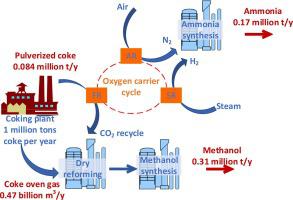Energy Conversion and Management ( IF 9.9 ) Pub Date : 2021-10-01 , DOI: 10.1016/j.enconman.2021.114796 Yaxian Zhao 1, 2, 3 , Yingjie Zhao 1, 2 , Qun Yi 4 , Ting Li 1, 2 , Jiancheng Wang 1, 2 , Weiren Bao 1, 2 , Liping Chang 1, 2

|
The efficient conversion of coke-oven gas (COG), an abundant by-product in steel production, into added-value chemicals such as methanol is a highly desired technological process. The state-of-the-art processes for the synthesis of methanol from COG possess several limitations such as poor utilization of hydrogen, low yields, and high energy consumption, leading to high production cost. The main technical issues are poor carbon supply and the need for energy intensification of the process. In this paper, we propose a new, more efficient method for the conversion of COG and pulverized coke (PC) into methanol and ammonia using chemical looping of hydrogen generation (CLHG), (PCCLHG-CGTMA). The PCCLHG-derived H2 and N2 are utilized for ammonia production. The new process has high adjustability in the production of methanol and ammonia. In order to obtain the best performance of carbon and hydrogen elements utilization efficiency, exergy and energy efficiency, several operational parameters and conditions have been optimized. Compared with different technologies for the conversion of COG to methanol or ammonia, the new system acclaims an excellent hydrogen element utilization efficiency of 88.8% and a high exergy efficiency of 78.7%. And the relative CO2 reduction ratio of this new system is 0.67. Considering the current market value and demands, 0.576 Mt/y COG and 0.175 Mt/y PC could be utilized in this process for the production of 0.44–0.86 Mt/y methanol and 0–0.36 Mt/y of ammonia. The present method offers exergy efficiency of 60.7–78.7% and energy efficiency of 54.4–70.1%. This study is a pioneering work in the utilization of all carbon resources during the coking process, which improves energy efficiency and reduces carbon emission and might represent a significant upgrade of coking industry.
中文翻译:

使用化学循环技术将焦炉煤气和焦炭转化为甲醇和氨的高度灵活和节能工艺
将炼钢中丰富的副产品焦炉煤气 (COG) 高效转化为甲醇等增值化学品是一项非常需要的技术过程。现有的 COG 合成甲醇工艺存在氢气利用率低、产率低、能耗高等诸多局限性,导致生产成本高。主要的技术问题是碳供应不足以及该过程需要能源集约化。在本文中,我们提出了一种新的、更有效的方法,使用化学循环制氢 (CLHG) (PC CLHG -CGTMA)将 COG 和粉状焦炭 (PC) 转化为甲醇和氨。PC CLHG衍生的 H 2和 N 2用于氨生产。新工艺在甲醇和氨的生产中具有较高的可调性。为了获得碳和氢元素利用效率、火用和能源效率的最佳性能,优化了几个操作参数和条件。与不同的 COG 转化为甲醇或氨的技术相比,新系统具有 88.8% 的优异氢元素利用效率和 78.7% 的高火用效率。和相对的 CO 2这个新系统的减速比是0.67。考虑到目前的市场价值和需求,0.576 Mt/y COG 和 0.175 Mt/y PC 可用于该工艺生产 0.44-0.86 Mt/y 甲醇和 0-0.36 Mt/y 氨。本方法提供的火用效率为 60.7-78.7%,能量效率为 54.4-70.1%。该研究是焦化过程中所有碳资源利用的开创性工作,提高了能源效率,减少了碳排放,可能代表焦化行业的重大升级。











































 京公网安备 11010802027423号
京公网安备 11010802027423号